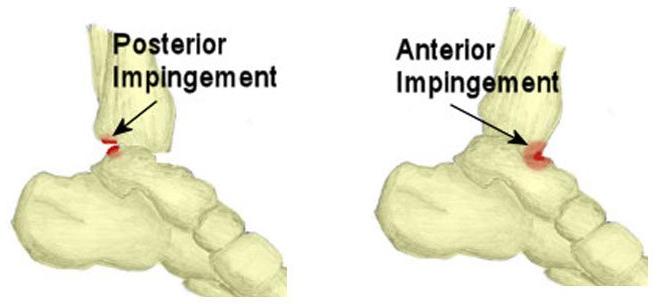FOOT & ANKLE
Ankle Impingement
The ankle is made up of many bones, muscles and ligaments that aid in the smooth movement of the foot. Ankle impingement is the painful limitation of movement of the ankle due to an abnormality in the soft tissue or bone. Impingement can occur in the front (anterior ankle impingement) or back (posterior ankle impingement) of the ankle.
Anterior ankle impingement is experienced in athletes whose actions involve repeated upward bending (dorsiflexion) of the ankle such as footballers, this causes irritation at the front edge, which in time can lead to impingement.
Posterior ankle impingement is a relatively rare occurrence seen in those who repeatedly stand on their toes or perform plantarflexion for example ballet dancers, gymnasts, dancers, jumping sports and causes pain and swelling at the back of the ankle.

Symptoms
Symptoms of ankle impingement include pain and swelling along the front and back of the ankle, which increases with movement. There may also be a painful clicking sensation when the foot is twisted inwards and outwards.
As anterior impingement progresses, it becomes chronic and additional symptoms may include instability; limited ankle motion; and pain with squatting, sprinting, stair climbing, and hill climbing. Normal gait may be unaffected. As anterior impingement becomes chronic, additional symptoms may include instability; limited ankle motion; and pain with squatting, sprinting, stair climbing, and hill climbing. Normal gait may be unaffected.
In posterior impingement there may also be joint line tenderness of the posterior tibiotalar joint (not involving the achilles tendon), limited plantar flexion and a ligamentous instability with thickening of the soft tissue.
Causes
The causes of ankle impingement include repetitive stress and irritation to the area, excess scar tissue formed with healing of an ankle sprain and/or bone spurs formed due to continuous wear and tear.
Diagnosis
Diagnosis is made by medical consultation, taking the patient's past medical history and examination of moving the foot through its full range of motion. The point of maximum tenderness is usually where the tissues are being pinched. X-rays and bone scans may also be ordered to rule out other conditions and confirm diagnosis.
Treatment Options
Non Operative Treatment
Non Operative treatment for ankle impingement includes:
- Physiotherapy to help improve ankle range of motion and break down scar tissue
- Rest and ice packs to help reduce pain and inflammation
- Immobilisation, placing the ankle in a cast or special boot to restrict movement
- Pain killers (paracetomol or panadol osteo) and anti-inflammatories if tolerated and not contraindicated
- Corticosteroid injections to the area may also help relieve inflammation
Surgery
In cases where symptoms persist and non operative treatment is ineffective, surgical treatment may be required by ankle arthroscopy. This involves excision of excess scar tissue, damaged tissue, bone spurs or other abnormalities through a minimally invasive procedure. Following treatment, a period of physical therapy rehabilitation is recommended to regain strength and flexibility of the joint.
Find out more about
Ankle Arthroscopy.

© All rights reserved
For all appointments and enquiries please contact us on:
Phone: 08 9779 9767
Email: admin@ryandusart.com.au
Address: 6 Higgins St, South Bunbury, 6230
